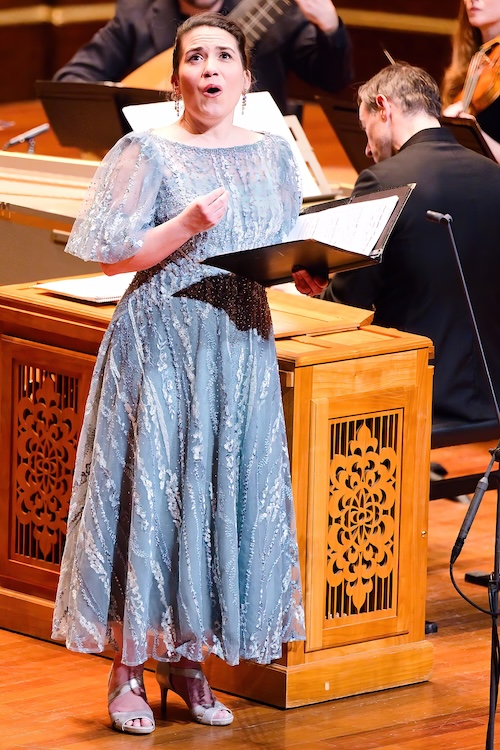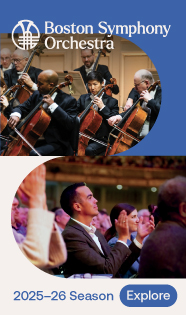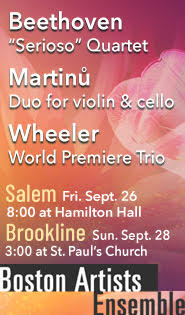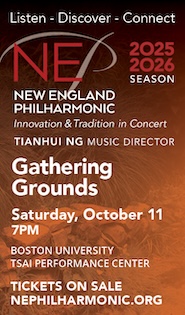Harvey, H&H dazzle in delightful program of Handel rarities

Soprano Joélle Harvey performed music of Handel with Jonathan Cohen leading the Handel and Haydn Society Friday night at Jordan Hall. Photo: Hilary Scott
One of Handel’s strengths lies in his rich experiences encompassing Europe, from his German heritage to his travels in Italy and eventual naturalization as a British citizen. In an expressively titled “Love, Handel” concert Friday night at Jordan Hall, the Handel and Haydn Society explored two of Handel’s cantatas that were written during his stay in Italy, as well as an instrumental work published in London but inspired by the Italian tradition.
The dedication of soloist Joélle Harvey and H&H was evident in showcasing the innate charm of Handel’s works, his tunefulness and joy in expression. In particular, the drama always moved forward under the direction of artistic director Jonathan Cohen in this performance of two cantatas, Delirio amoroso and Tra le fiamme.
A brief prelude by the H&H Youth Choruses Chamber Choir included two English-language choruses from his oratorios: “O Love Divine” from Theodora and “Happy We!” from Acis and Galatea.
Then, the opening oboe theme, played by principal Debra Nagy, introduced the cantata Delirio amoroso, HWV 99. The Italian influence is immediately clear in the violin lines, and the H&H violinists timed the ricochets with the perfect amount of fiery excitement.
Soprano Harvey possesses the ideal Baroque and Classical tone quality—with a silvery shimmer but also a distinctly smooth, velvety core. Aided by her charismatic stage presence, the soprano glided effortlessly and sensitively through Handel’s music.
One offbeat element of this cantata is that an objective narration sandwiches the first-person exploration of thoughts. Harvey delineated these roles effectively, making the most dramatic aspects of her performance emerge in the middle when embodying the twice-rejected Chloris. This character is complex: mad with unreciprocated love yet still guiding the dead Thyrsis, the object of her admiration, to Elysian Fields (although the closing text suggests that this may all have been imagined).
The first aria “Un pensiero voli in ciel” featured thrilling virtuosic violin lines and concertmaster Aisslinn Nosky produced sparks each time. Harvey’s soaring sound melded with the orchestra in breathless coloratura—though clearly not breathless to the soloist who sounded as if she contained infinite air capacity in her sustained notes. Harvey and the H&H ensemble embodied the epitome of Baroque virtuosity, decorated figures balancing the graceful underlying pulse.
Harvey’s dramatic and sensitive pull was most audible in recitatives, even more than in arias—each line was delicately crafted, attentive to text and the personality of the character. This coloring was especially effective with Chloris undergoing widely varied emotions, as with her cry on “Tirsi, o Tirsi.”
The second aria “Per te lasciai la luce” displayed raw drama, the lower rasp of principal cellist Guy Fishman adding to the darkness. Harvey’s vocal control floated the tenderest pleas in these lines. The final aria “Lascia omai le brune vele” with its catchy, charming little dance, showcased H&H’s graceful musical phrasing.
The Concerto Grosso in G Major, Op. 6, no. 1, followed the cantata and also demonstrated H&H’s unified sound, with the music coming consistenly alive across all collective voices. The introduction was appropriately stately with its cadence almost resolving into the spritely Allegro, which then slowed down tastefully into an Adagio.
The playing in the Adagio was exquisitely controlled over a light, propelling counterpoint. The ensuing Allegro opened with sensitive imitation and expanded with hope in uplifting figures. The triple-meter last movement’s bird-like figures in strings danced gracefully within the joyful ensemble.
Harvey withheld some power of her sound in Tra le fiamme, which worked well with the generally lower tessitura, calmer drama, and balancing with the obbligato viola da gamba. Matt Zucker’s playing added a metallic undertone to the ensemble’s aesthetic, sounding somehow simultaneously bowed and guitar-like in articulation.
Harvey’s charming stage presence engaged the audience in the storytelling, in more recitative moments such as “…il cader è costume” tagging the cadence like an after-thought in a witty punchline.
There was certain visual and musical flair in the viola da gamba in the second aria “Pien di nuovo e bel dietto” with large string crossings for the lower bass note drop after the light procession of triple-triplet figures. “Voli per l’aria chi può follare” was a brisk storm in the minor, decorated with lovely coloratura ensemble moments with soprano and viola da gamba and recorder, played also by Nagy.
An encore of the aria “Tornami a vagheggiar” from Handel’s opera Alcina thrilled especially in the da capo section with brave ornamentation and thriving character from Joélle Harvey, who is sure to become one of Boston’s favorite singers.
The program will be repeated 3 p.m. Sunday at NEC’s Jordan Hall. handelandhaydn.org
Posted in Performances


